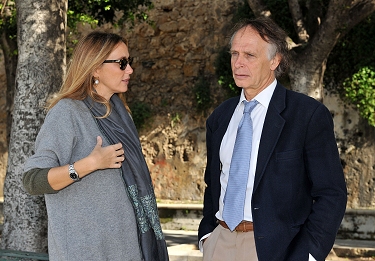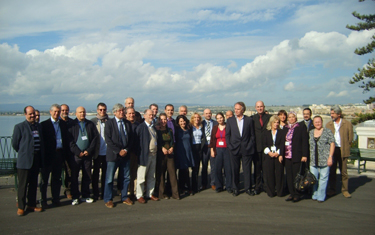 Mediterranean Marine Peace Parks for conservation – a bold CIESM initiative Mediterranean Marine Peace Parks for conservation – a bold CIESM initiative
01 Dec. 2010, CIESM News |
| Creating coast-to-coast, trans-frontier marine peace parks to preserve the best of Mediterranean marine diversity across political and cultural divides ... this is not a dream but a new, realistic vision backed-up by CIESM marine scientists who met at the end of November in the ancient Sicilian city of Syracuse (Italy).
The Mediterranean Science Commission invited 30 international marine researchers1, all experts of the region, to this brainstorming Workshop in order to identify priority sectors of the Eastern and Western Basins hosting unique, vulnerable geological, ecological and oceanographic features2. Seamounts, sites of deep water formation, breeding and feeding areas of endangered species such as the monk seal and the blue fin tuna, deep-sea hypersaline basins, figured among the many criteria considered in the geographic selection. |

Prince Albert of Monaco and Prof. Frederic Briand of the Mediterranean Science Commission in Syracuse, Sicily, where they launched the Marine Peace Parks initiative for the Mediterranean Sea (October 2010). [Photo: F.Fabre] |
Eight large marine areas have been selected: they include the Pelagian Sea, the Strait of Gibraltar sensu lato, sectors of the Ionian, Adriatic, north Levantine and south Aegean Seas. "One major innovation of these marine parks" – said Frederic Briand, Director General of CIESM – "is that they will encompass both coastal areas and high seas, allowing for a continuum of harmonized protection measures, agreed between the concerned countries over vast expanses of sea. For us scientists, this seems the only way to ensure effective, long-term functioning of whole marine ecosystems and the maintenance of marine populations often dependent on broad ranges." He added that this proposal was innovative in another way: "such a trans-boundary system would improve existing relations between neighbouring States, and render current disputes over the precise demarcation of maritime frontiers less and less relevant. This is why, said Briand, we are proud to call them 'Marine Parks for Peace': peace for the sake of sustainable conservation of the Mediterranean Sea".
But how realistic is the idea of protecting large areas of the Mediterranean Sea where human pressures such as coastal developments, maritime traffic, fishing are at peak levels? “We need to move away from the obsolete concept of considering marine protected areas like fortresses – continued Briand – we need to apply spatial planning and allocate within each of these parks distinct zones having different levels of protection.” “For example – added Enric Sala, the Workshop co-Chair and National Geographic Explorer – some zones would be temporarily restricted to fishing, allowing for the replenishment of fish stocks, others would be devoted to international marine research, while vessels transporting dangerous substances would follow well-defined maritime corridors, away from particularly vulnerable areas, as happens with air traffic control”.
|

The Italian Environment Minister, Stefania Prestigiacomo in conversation with Frederic Briand, CIESM Director General, at the conclusion of the Syracuse Workshop. [Photo: Gaetan Luce] |
With the growing number of self-declared EEZ3, the fate of most, if not all, of the Mediterranean Sea will be soon under national sovereignty. “Which means – concluded Frederic Briand – that the legal context is in place to move on; and that political goodwill is what we most critically need now”.
The first supporting voice * was that of Stefania Prestigiacomo, the Italian Minister of the Environment, who attended the concluding session of the CIESM international meeting in Syracuse: “Italy – she said – a founding Member State of the Commission, encourages CIESM to move ahead with this important initiative calling for trans-frontier marine parks. We absolutely need concrete propositions like this one to better protect our Mediterranean Sea”.
The process is well engaged: the President of the Mediterranean Science Commission, Prince Albert II of Monaco, concluded the workshop with a promise to take the CIESM Marine Peace Parks initiative to the highest political level **, so as to reach the Nagoya CBD objective to protect over 10% of the world ocean well ahead of 2020 for the Mediterranean4. |

A short break from the discussions of the CIESM Workshop 41 on transfrontier marine protected areas. [Photo: CIESM]
|
________________________________________________________
1 From left to right in the group picture: Drs Mustapha Aksissou (Univ. Tetouan, Morocco), Ricardo Aguilar (Oceana, Madrid, Spain), Maurizio Wurtz (Univ. Genoa, Italy), José Templado (Museum Nat History, Madrid, Spain), Bayram Ozturk (Univ. Istanbul, Turkey), Roberto Odorico (Miramare Mar. Reserve, Trieste, Italy), Salvatore Mazzola (IAMC, Naples, Italy), Vangelis Papathanassiou (HCMR, Athens, Greece), Miroslav Gacic (OGS, Trieste, Italy), Giuseppe Notarbartolo di Sciara (Tethys, Milano, Italy), Peter Mackelworth (Blue World Inst., Losinj, Croatia), Marie Romani (MedPAN), Enric Sala (CSIC, Barcelona, Spain), Sylvaine Giakoumi (Univ. Aegean, Greece), Jean Mascle (GeoAzur, Villefranche s/mer, France), Paula Moschella (CIESM), Sajmir Beqiraj (Univ. Tirana, Albania), Anastasia Miliou (Archipelagos, Greece), Chedly Rais (Okianos, Tunisia), Frederic Briand (CIESM), Aleksandar Joksimovic (Inst. Marine Biol., Kotor, Montenegro), Myroula Hadjichristoforou (Cyprus), Simona Fraschetti (Univ. Salento, Lecce, Italy), Howaida Zakaria (NIOF, Alexandria, Egypt), Daniel Menchero (RAC/SPA, Tunis), Adriana Vella (Univ. Malta), Ali Cemal Gucu (METU, Erdemli, Turkey).
2 CIESM Workshop 41 – Mediterranean Marine Peace Parks for Conservation – A CIESM initiative. Syracuse, Italy, 18-20 November 2010.
3 Under the Law of the Sea, an Exclusive Economic Zone (EEZ) is a sea area over which a State has special rights over the exploration, protection and use of marine resources. It stretches from the seaward edge out to 200 nautical miles (or less if there are claims from other sovereign States on the way). In casual usage, the term includes the territorial sea and even the continental shelf beyond the 200 mile limit.
4
At this time less than 1,5% of the Mediterranean Sea is explicitly and effectively protected.
|
Further info:
CIESM (www.ciesm.org), the Mediterranean Science Commission, is supported by 23 Member Governments to promote international research in the Mediterranean and Black Seas. The Commission covers a broad spectrum of marine disciplines, relying on a pool of vast human resources: over 4,000 marine scientists from some 550 research institutes in more than 30 countries. On this basis, CIESM produces authoritative, impartial reports on the status and trends of Mediterranean marine systems, together with sharp recommendations on priorities for action, research and development on a large range of sensitive issues concerning the whole Mediterranean Basin.
CIESM | 16, bd de Suisse | MC 98000 Monaco | Tel. +377 9330 3879 | Fax +377 9216 1195 | contact@ciesm.org
|
|



